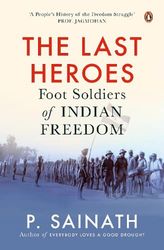Hausabai Patil set fire to dak bungalows, looted trains and once, in a covert operation, freed her comrade from the clutches of the Portuguese. Part of the Toofan Sena―the armed wing of the provisional government of 600 villages in Satara that overthrew the British government in 1943―she spied on police officers, acted as a decoy and swam across the Mandovi river for a mission. Yet, history has made no space for her. Till now.
For years, the struggle for independence has been dominated by heroes and leaders. P. Sainath’s The Last Heroes: Foot Soldiers of Indian Freedom has finally let the aam aadmi into history. They are ordinary, and that is what matters. “There is a lovely African saying: ‘Until the lions have their own historians, the history of the hunt will always glorify the hunter’,” says Sainath. “It has never left me for 20 years. My point is that, if ordinary people told you the stories of history, the struggle for independence would look very different. They were the lions.”
The book documents 15 such lions. Among them were Bhagat Singh Jhuggian, who fought for the revolutionary underground in Hoshiarpur; Demati De Sabar ‘Salihan’, who at 16―with 40 other tribal women―fought the armed police with lathis and won; Laxmi Panda from Orissa who joined the Indian National Army; and Chamaru Parida from Panimora, the badmash gaon (rogue village) that sent 32 people to prison in 1942.
The individual acts of defiance of these people fall short of the bureaucratic definition, and hence they are excluded from official lists of freedom fighters―both in the states and the Union government. “It excludes women by definition,” says Sainath. “The 1980s scheme document uses the word ‘widow’ rather than ‘spouse’, which assumes that freedom fighters were only men.” But in reality, he says that millions of women took up extremely dangerous and hazardous jobs in the revolution.
The Last Heroes: Foot Soldiers of Indian Freedom expands the narrow definition of freedom to allow diversity and chronicle resistance in all its forms and in every shade of courage. As Panda asks, “Because I never went to jail, because I trained with a rifle but never fired a bullet at anyone, does that mean I am not a freedom fighter?” Panda begged her parents to join INA to free India in Burma. But she was hesitant to speak about her role as she cleaned people’s houses in free India. “Look at the work I am doing,” she said in an interview. “I am cleaning people’s houses. I am embarrassed to tell you or anyone that. Who will think of me as a freedom fighter?”
Beyond just a documentation of foot soldiers scattered across the country, Sainath’s book demonstrates that resistance always existed. “The adivasis of India were the first to fight for freedom,” he says. “And the last to benefit.” It also busts the myth that there were only a few ways to fight for freedom. So, you did not need to choose between Gandhi and Ambedkar. “If I were to describe them, most were clearly leftist in their politics and Gandhian in their moral code,” says Sainath.
The Last Heroes is essential reading, not only because Sainath has chosen to bring them into the space of history, but also because it chronicles what India has lost as the generation that fought colonialism slowly dies out. It also serves as a reminder the battle is far from over. The book begins with a line by Captain Bhau, aka Ramchandra Sripati Lad, the leader of the Toofan Sena. “We fought for two things―freedom and independence. We attained independence.”
The Last Heroes: Foot Soldiers of Indian Freedom
By P. Sainath
Published by Penguin Random House
Pages 272; Price Rs499


